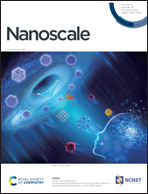Molecular simulations of the interfacial properties in silk–hydroxyapatite composites†
Abstract
Biomineralization is a common strategy used in Nature to improve the mechanical strength and toughness of biological materials. This strategy, applied in materials like bone or nacre, serves as inspiration for materials scientists and engineers to design new materials for applications in healthcare, soft robotics or the environment. In this regard, composites consisting of silk and hydroxyapatite have been extensively researched for bone regeneration applications, due to their reported cytocompatibility and osteoinduction capacity that supports bone formation in vivo. Thus, it becomes relevant to understand how silk and hydroxyapatite interact at their interface, and how this affects the overall mechanical properties of these composites. This theoretical–experimental work investigates the interfacial dynamic and structural properties of silk in contact with hydroxyapatite, combining molecular dynamics simulations with analytical characterization. Our data indicate that hydroxyapatite decreases the β-sheets in silk, which are a key load-bearing element of silk. The β-sheets content can usually be increased in silk biomaterials via post-processing methods, such as water vapor annealing. However, the presence of hydroxyapatite appears to reduce also for the formation of β-sheets via water vapor annealing. This work sheds light into the interfacial properties of silk–hydroxyapatite composite and their relevance for the design of composite biomaterials for bone regeneration.



 Please wait while we load your content...
Please wait while we load your content...